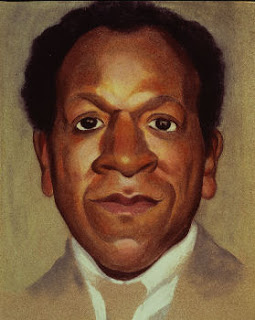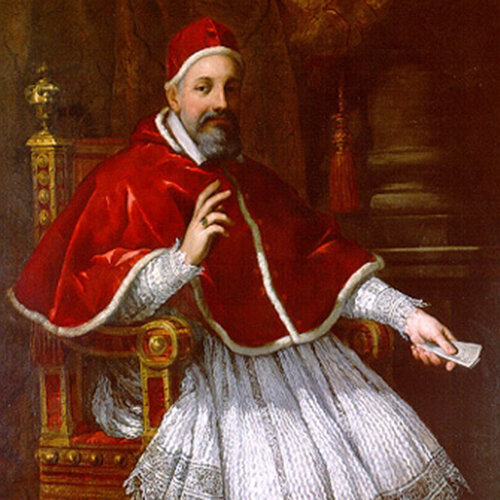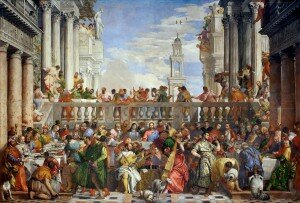
Veronese: The Wedding at Cana (1563)
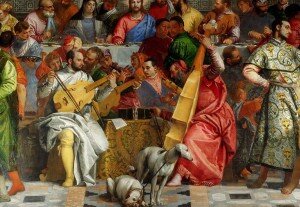
Veronese: The Wedding at Cana (1563) (central detail)
When the painting was in place, it made the refectory seem an extension of the painting.
At the centre of the painting and the centre of the festivities is a small ensemble. On the table, held up with the aid of an hourglass is a book of music in a dark cover. The players on the left and right are looking into their own part-books.
Ortiz: Recercada quarta (Musica Antiqua of London; Philip Thorby, cond.)
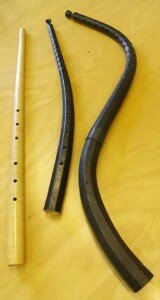
Three cornetts: Mute, curved, and tenor
Arcadelt (arr. Ortiz): O felic’occhi miei (James Tyler, tenor viol; Anthony Rooley, lute)
First let’s identify the instruments: all of them are from the viola family – from left to right: tenor, melodic bass (tuned an octave above the bass), soprano, and bass viola. The wind instrument is a cornetto – a wood instrument played with a trumpet-like mouthpiece.

A profile of Ortiz from his music treatise Trattado de Glosas (1553) and his image in the Veronese painting
Through history, the identity of the man with curly hair playing the melodic bass viol hasn’t been identified. The authors of the 2017 article however think that he is Diego Ortiz himself, and showed this illustration to support their idea:
The players, then, from left to right are: Veronese (tenor viola), Ortiz (melodic bass viola), Jacopo Bassano (cornetto), Tintoretto (soprano viola), and Titian (bass viola). The position of Ortiz is such that he looks as though he’s whispering in Veronese’s ear. His music book just barely appears behind Veronese’s head.
Ortiz: Passamezzo moderno (James Tyler, tenor viol; Anthony Rooley, lute)
In addition to their artistic skills, the painters were also associated with music: Veronese designed 2 organ complexes for two different churches and Tintoretto was a competent musician. Titian did a painting of the instrument maker Alessandro Trasuntino and was paid with an organ. The painters shown as instrumentalists are more than a metaphor. It was a way of putting them at the centre of the action with a reason to be there. Being joined by the greatest performer on the viol, in their own consort of viols, was a tribute to all concerned.
Source: Lafarga, Manuel, Teresa Cháfer, Navidad Navalón, and Javier Alejano. Il Veronese and Giorgione in Concerto: Diego Ortiz in Venice/El Veronés y Giorgione en concierto: Diego Ortiz en Venecia (bilingual edition, English translation by Christian Michel).(Cullera VLC: Lafarga & Sanz Ediciones, 2017)


